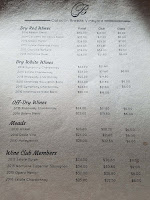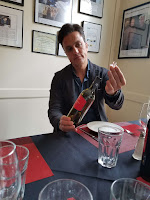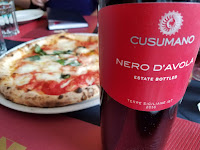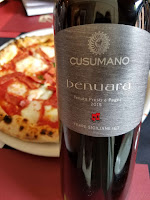A huge thanks to Jenn Nelson of
Wine Antics for live blogging the
Wine Writers, What Are They Looking For? session at the
2018 US Wine & Beverage Conference. This two-day conference in Washington D.C. is targeted towards wineries to provide education in the fields of vineyard management, wine-making, and marketing. The Wine Writers session was one of a few that were very relevant to content providers and fortunately I was able to watch the proceedings live via Jenn's
video. This session was moderated by Eric Guerra, Chief Marketing & Sales Officer
Terravant Wine Company, and featured Carlo DeVito Owner
Hudson-Chatham Winery plus three wine writers:
Lenn Thompson,
Frank Morgan, and
Paul Vigna. A stellar cast. I would strongly encourage interested readers to watch the entire
video, but here are my comments on what was discussed and what was omitted. Cheers.
Educate Tasting Room Staff
This dictum should be obvious but even the organizers of USBevX realized it's lacking since they created a session on this very topic. Perhaps, turnover is a contributing factor, but I continue to witness this irritating display of ignorance. On one extreme, I remember Dezel Quillen's (
MyVineSpot) story how he mispronounced Virginia's signature grape Vee-og-ney for a substantial period because that's how a staff member pronounced it during his introduction to the grape. On the lesser extreme I've engaged staff who are unfamiliar with where a vinifera grape originated, a blend composition, or even what grapes are planted in the estate vineyard. Simply unacceptable. And staff should be honest if they do not know the answer to a question. Do not guess. One tip that Lenn Thompson suggested was not only sending writers technical sheets, but post that information on your website. I would expand that and suggest having technical sheets available at the tasting room. At the very least, it would assist educating the staff and more importantly it can be distributed to wine geeks who ask more probing questions.
Tell a Story
How can wineries differentiate their brand from the hundreds or even thousands of competing options? That question not only was raised during this session, but has been overarching dilemma of the craft wine explosion. In addition to producing the best wine possible, a common answer is to create compelling stories behind your establishment. Frank Morgan mentioned
Old Westminster Winery as an example with their family story and social media engagement. However, the story doesn't have to revolve solely around the family. The region's history can be stressed as is the case at
The Winery at Bull Run who display Civil War artifacts in their tasting room. Another option is highlighting a particular grape variety.
Hudson-Chatham's story revolves around Baco Noir -- although their Chelois is just as intriguing. If you produce an Albarino, focus on the grape's Galicia home as well as how your wine differs from those from Riax Baixas - perhaps through annual comparative tastings. Even normally pedestrian grapes such as Pinot Gris can be a focal point. Recently I tasted a rather noteworthy Pinot Gris from
Boordy Vineyards. When I mentioned this to Dr. Joe Fiola, his eyes gleamed as he enthusiastically discussed the specific vineyard block that produced that wine. Boordy should share that knowledge - perhaps present samples of dirt in the tasting room and explain how the soil and sunlight affect the wine. Provide us a reason to visit.
Expand Beyond Experienced Content Providers
A valid question was raised during the seminar on how to differentiate between the bloggers, particularly when new content providers seem to be appearing overnight. The panelists gave two equally valid responses. First, look for content providers who have organically written about your area as this demonstrates a degree of excitement towards your location. Paul Vigna's
Penn Live is a nice example of an outlet that reports on winery tours in underrepresented locations. At the very least any state or regional winery board worth their salt should have a list of content providers that have written about that area. The second response was to seek content providers who have large audiences. Now in some instances, these audiences may simply be the result of longevity, but at least the blogger\writer has sustained a passion for covering the wine industry.
However, I would caution about relying solely on these more experienced bloggers. You could easily overlook many talented and engaging content providers with small but growing readership. Being in the longevity camp, it is refreshing to encounter younger and perhaps more enthusiastic content providers who are not just seeking free samples. And in the DMV region there is no shortage of groups that you can contact to locate these individuals. A few Facebook examples are the
Young Wino's of DC,
Black Wine Lovers, and I have to include the more senior
Virginia Wine Mafia.
Finally, the discussion was exclusively focused on print. Yet there's a large array of media that are covering craft beverage industries.
Wine Antics is one example of live video blogging. There are also podcasters, social media providers, and others outside my realm. Try something different such as
Winemaker's Drinking Beer. There are numerous outlets beyond experienced print bloggers.
 I paid a quick visit while heading to Liberty Mountain Resort - only 20 minutes away. For hikers, Cunningham Falls State Park is even closer, 10 minutes to the south. Visitors are offered three tasting packages: Signature ($10), Premier ($12), or Sweet ($8) - the later including three Mead wines. However, I chose the Premier tasting in order to sample their estate wines. For whites, this included the 2015 Serenade Sauvignon Blanc ($24) and the 2015 Estate Chardonnay ($24). And seeing my interest in their estate portfolio, the staff member provided a sample of the wine club only 2016 Estate Chardonnay ($24). The two Chardonnays exhibit completely contrasting styles as the 2015 is more full bodied (my preference) and the 2016 racier with cleaner fruit.
I paid a quick visit while heading to Liberty Mountain Resort - only 20 minutes away. For hikers, Cunningham Falls State Park is even closer, 10 minutes to the south. Visitors are offered three tasting packages: Signature ($10), Premier ($12), or Sweet ($8) - the later including three Mead wines. However, I chose the Premier tasting in order to sample their estate wines. For whites, this included the 2015 Serenade Sauvignon Blanc ($24) and the 2015 Estate Chardonnay ($24). And seeing my interest in their estate portfolio, the staff member provided a sample of the wine club only 2016 Estate Chardonnay ($24). The two Chardonnays exhibit completely contrasting styles as the 2015 is more full bodied (my preference) and the 2016 racier with cleaner fruit. For reds, the Premier tasting started with the 2015 Estate Cabernet Franc ($36) a relatively big Cabernet which was a little choppy with noticeable dark cherry fruit, tannins, and spices. I'd like to return to this wine after a few years in bottle. 2014 Concerto Bordeaux Blend ($35) is a blend of four Bordeaux grapes and is ready to drink now - a more textured character with a juicy clean tail. For several years Dr. Joe Fiola has encouraged Maryland vineyard owners to plant Barbera and Catoctin Breeze has leveraged that suggestion by producing that 2015 Oratorio Barbera ($38). This wine possesses the stereotypical high acids and low tannins while proving a decent fruit profile. The high end of the price range for sure. Finally, my attendant poured a sample of the case club only 2015 Estate Syrah ($34) - one of the wines they featured at the 2018 Winter Wine Showcase. Let's just say, I joined the case club in order purchase a couple bottles of this wine. This is by far the nicest wine coming from their estate. Cheers and as always theCompass Craft Beverage Finder will guide you to Catoctin Breeze Vineyard.
For reds, the Premier tasting started with the 2015 Estate Cabernet Franc ($36) a relatively big Cabernet which was a little choppy with noticeable dark cherry fruit, tannins, and spices. I'd like to return to this wine after a few years in bottle. 2014 Concerto Bordeaux Blend ($35) is a blend of four Bordeaux grapes and is ready to drink now - a more textured character with a juicy clean tail. For several years Dr. Joe Fiola has encouraged Maryland vineyard owners to plant Barbera and Catoctin Breeze has leveraged that suggestion by producing that 2015 Oratorio Barbera ($38). This wine possesses the stereotypical high acids and low tannins while proving a decent fruit profile. The high end of the price range for sure. Finally, my attendant poured a sample of the case club only 2015 Estate Syrah ($34) - one of the wines they featured at the 2018 Winter Wine Showcase. Let's just say, I joined the case club in order purchase a couple bottles of this wine. This is by far the nicest wine coming from their estate. Cheers and as always theCompass Craft Beverage Finder will guide you to Catoctin Breeze Vineyard.



















